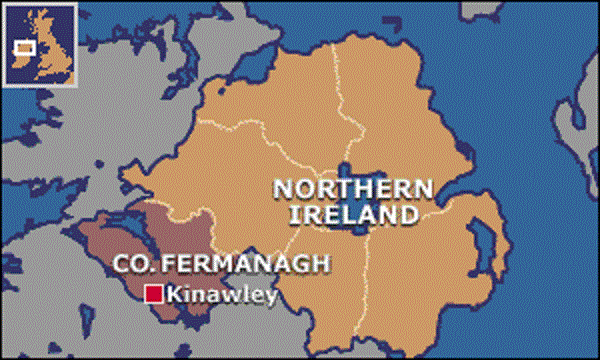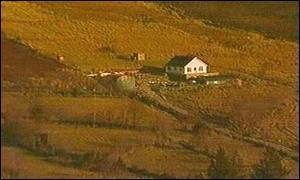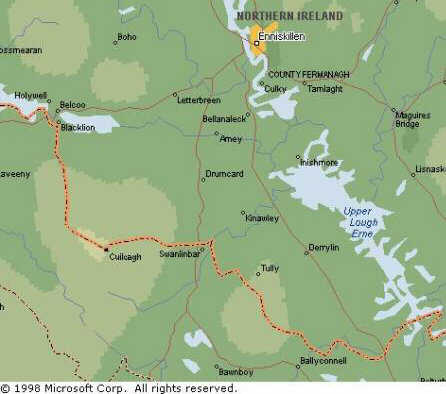BBC News, February 13, 2001One day later the same site had the following report:
Aircraft crashes on mountain
Police in Northern Ireland are investigating reports that a light aircraft has crashed in County Fermanagh.
It is understood that a plane came down at Benaughlin Mountain near Kinawley shortly after 1800 GMT.
It is believed helicopters are being used in the rescue effort.
Tuesday, 13 February, 2001, 20:56 GMT, BBC NewsAnd then, a dark blanket was cast over over the whole event; and officials discarded it as a 'genuine error'. That may or may not have been the truth, or the full extent of it at least but one thing is for certain -- it killed the story.
Mystery surrounds 'plane crash' reports
Mystery surrounds the source of flames and smoke in the sky over County Fermanagh which has sparked a major search operation.
About 12 people described seeing flames and smoke on the side of the Benaughlin Mountain, near Kinawley, on Tuesday night.
Paul McCaffrey, who raised the alarm with a friend, is convinced he saw something in the sky with smoke billowing from it.
"I saw a dot at the front and a black trail of smoke leading down at an angle towards the mountain," he said.
A British Army helicopter using heat sensitive equipment also flew over the area.
But following more than three hours of extensive searches, nothing was found.
The appearance of a quick-paced cover-up raises the possiblity that there is more to this story than meets the eye. In other words, the event itself was insignificant at face value, but a brief look below the surface tells otherwise.
A Turmoil At First And Then Silence
Airports reported that no planes had gone missing, every single airplane had been accounted for. That effectively ruled out any commercial airplane, surely. But it left the non-commercial airplanes, or the military plane, or perhaps an impact from outside. Yes, meteors. How else can the bringing in of army material carrying infrared sensors being explained?
They knew full well there were no human casualties expected to be found on site as it was not a normal airplane involved. But something of interest was there to be found for them, important enough to have army helicopters search the area for almost an entire day.
The Sightings
The area is a remote one, loved by back-packers and nature lovers for its rough nature with ample opportunity for walking.
According to photos, Benaughlin Mountain can be viewed from the slopes of Cuilcagh. This is EXACTLY on the NI-I border. Judging from the field of view being Eastward to East by NE (looking at the positions of shadows and clouds, the Sun is shining from the right side there,) then Benaughlin Mountain must be somewhere on the line from Cuilcagh mountain to Kinawley, from where the sighting was made and the emergency services were called. (They went as far as they could into the rugged terrain, so they must have been ploughing their way West.)
About 12 people described seeing flames and smoke on the side of the Benaughlin Mountain, near Kinawley, on Tuesday night. (looking East to West from Kinawley that would be either the North or South flank)
When Mr McCaffrey saw a dot (he doesn't mention it coming overhead, he would have if it had) he must have seen it coming 'towards' him. If something burns and moves, the flames will be behind the moving object. Seeing it then means having it move generally towards you.
If he has been looking from Kinawley, then it must have approached the mountain which was in front of him on the West side from even further West. Therefore it must have been moving West-to-East, again this is generally. So if it has been a meteorite, it again was one "catching up" with the planet, since the time of day was shortly after Sunset. As we rotate away from the Sun towards the East when evening falls (the article mentions shortly after 1800 GMT.)
This meteorite must again have caught up with Earth and struck the planet 'from the back'. Why is this so significant? Any such rock must have been coming in towards us from about the region where Venus was a few months ago, generally.
We may indeed have had another meteor impact catching up with us, perhaps as a result of the comet 76P/ Mars rendez vous, rocketing towards us around Venus, possibly. Perhaps a closer look that way with a strong telescope would shed some light onto this matter.
The Possibility of a Meteorite
Aren't meteorites terribly hot stones when they enter on a crash course into our atmosphere? Well, they may be on the outside, but not on the inside.
At least that is what becomes clear from the posting from a French newsgroup below:
From: "Thierry LOMBRY"
<email adress obscured for privacy reasons>
Newsgroups: fr.sci.astronomie
Sent: Friday, March 02, 2001 13:09
Subject: Re: Température d'une météorite
Original Posting
Rebonjour,
En fait dans les faits la croûte en fusion qui est fondue ou vitrifiee ne
dépasse jamais quelques 10e de mm.
Comme tu l'as l'intérieur reste intact mais pour 2 raisons :
- la partie externe de la météorite s'est volatisee dans l'atmosphere
emportant avec ella la chaleur
- et l'incadescence ne durant que le tps de la traversee de l'amosphere,
qlq
sec, la chaleur ne peut pas diffuser jusqu'au coeur..
Raison pour laquelle les météorites gardent intact les origines de leur
passé.
Thierry
English Translation
Hello again,
In fact in reality the crust portion which is grilled or evaporated never exceeds several tenths of a mm.
Like you said the interior remains intact but for two reasons:
- the external portion of the meteorite has vaporized off in the atmosphere taking with it the heat
- and the glowing doesn't last longer than the time of passing through the atmosphere, a few seconds, the heat cannot even dissipate towards the centre..
That's the reason why meteorites keep the origins of their past intact.
Thierry
Original ReplyThis is indeed an eye-opener. What this says basically is that even though the outer shell of an asteroid burns and vaporizes during entry into our atmosphere, its core remains at the temperature of outer space, which may easily be minus 100 degrees Celsius or even lower, approaching absolute zero!
"Philippe Printant" <email not disclosed for privacy reasons> wrote in message
news:3A9E3B8F.933AE844@clu b-internet.fr...
Bonjour,
a priori,
1- on commence par brûler de chaud;
2- puis au bout de quelques instants (combien?), on prend un méchant coup de froid;
3- au bout d'un temps plus long (combien ?), la météorite est à la température ambiante : il n'y a plus de risque.
En effet, suite à la chute, la croûte est brûlante. Mais comme la météorite a voyagé très longtemps dans le vide glacial, son coeur est proche de 0 K et ce n'est pas le rapide passage dans l'atmosphère qui le chauffera. La croûte refroidit vite et sa température s'approche de celle très froide de ce coeur. Puis enfin, le tout finit pars'équilibrer avec l'air ambiant.
Cette explication logique se retrouve dans "Les météorites et leur impact" d'Alain Carion (éd Masson), p 12 (2ème éd.).
A noter que le site suivant n'évoque que le 2ème temps de ces effets:
http://www.themeteorites. com/TM2/frscchute.htm
Cordialement
Philippe Printant
club du Trégor
English Translation
Hello,
first,
1- one will start to burn from the heat;
2- then, after a few instants (how many?) one will get a nasty hit by the cold;
3- after the passing of a longer time (how long?), the meteorite comes at the temperature of the surroundings: there is no more risk.
In fact, following the fall, the crust is burning. But as the meteorite has travelled a very long time through the icy void, its heart is near zero Kelvin and it won't be the fast passing through the atmosphere which will heat it back up.
The crust will refreeze quickly and its temperature will again approach that of the very cold interior. All at last, the whole finishes by reaching an equilibrium with the surrounding air.
That logical explanation is located in " book title", page 12
Noteworthy is that the following site only brings up the second phase of these effects:
URL
Kind regards,
Philippe.
That may also be why the army searching with Infrared equipment could not find anything, not even after only an hour. Had they profiled the area for temperature variations downward, they might have found something. The stone would have been icy cold only minutes after striking the ground, remaining undetected by the heat sensitive equipment.
The outer few mm's of a rock of a foot in diameter would have been very hot, but only for moments after impact, after that the intense cold from within would have absorbed the heat, after which the whole rock would gradually come to environment temperature, not down but UPWARDS. Thus remaining untraceable in the night with IR view, if you don't know what you are searching for. Now, only going out there into the barren grounds yourself may give a result, a visual one by finding the stone yourself.
Hoax or Cover-up?
The theory presented in the posting above must have been common knowledge also to meteorologists and to a lesser extent also army personnel. So why would they only call the search off after a day and not before, or why would they not search using a different method if they knew it involved a meteorite? They knew very soon it could not have been an airplane. So they must have considered the possibility of a rock from outer space.
So why label it a hoax, and thereby ignoring what dozens of credible witnesses claim to have seen? Was this a cover-up or an elaborate hoax after all. The truth lies somewhere in the hills West of Kinawley.
It could, just possibly, be the first of more similar events to hit us, precursor events to a bigger impact impending upon us, an impact of great consequence to our planet. Something NASA has even dedicated a few satellite missions to. Maybe that is why the authorities don't want this to attract too much attention. They want to keep preparing themselves in silence, so the lid was put back on in a hurry. How much longer still do we have to wait to find out?






Seems like a useful cooking reminder in the kitchen when using the deep fat fryer.